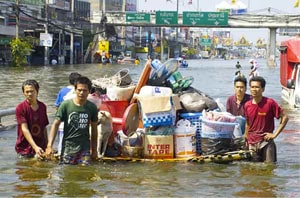EXPECT THE UNEXPECTED
By Paula Green
Recent natural disasters in Japan and Thailand highlight the need for companies to insure against business interruption.
 |
| Photo Credits: RUCHOS / SHUTTERSTOCK.COM |
About the only sure thing risk managers and their insurers will find in the marketplace for business interruption insurance is uncertainty. Buyers and underwriters of this crucial coverage have always had their work cut out for them. They need to nail down the unknown risks that can slash corporate revenue streams that are increasingly dependent on complex supply chains flung across time zones and cultures. But calamities such as the 2011 Japanese tsunami and floods in Thailand have only heightened corporate anxiety over the red ink that can flow when a supplier––or a supplier’s supplier––is forced to close its doors.
 |
|
Montanez, Ace Hardware: Our business continuity plan is an integrated part of enterprise risk management |
“The natural catastrophes have been a wake-up call for both companies and insurers. A large part of the insured losses were caused by business interruption or contingent business interruption losses,” says Volker Muench, global head of strategy and development property underwriting at Allianz Global Corporate & Specialty (AGCS) in Munich. “Carmakers in Europe or personal computer producers in the United States, for example, felt the effects of these catastrophes in Asia as some of their key suppliers dropped out of business. These events have demonstrated how vulnerable global supply chains have become,” says Muench. “As a consequence, many companies are working on improving the resilience of their supply chains.”
These forces of nature, along with the specter of global health pandemics and man-made misadventures like violent street protests in Greece and the Middle East, also have raised awareness of the need for contingent business interruption insurance, or CBI, which truly can veer out into unknown territory. Also known as contingent business time element coverage, CBI covers multinationals against many of the same named perils––whether fires, floods or earthquakes––that can force a company to close its doors temporarily and lose precious revenue. But CBI goes a step further and covers a company for income streams lost when a supplier––or even a supplier’s supplier––has to temporarily shut down operations because of a named peril. It can also protect against temporary losses of income if a customer’s stores are shuttered for a few weeks by a hurricane, for example, and the customer can no longer buy the insured company’s products. “Many CBI losses [from the Thai floods] were further complicated with complex supply chains that included various tiers of impacted suppliers,” says Frank Russo, managing director of Aon Global Risk Consulting. “The further removed a company is from a loss, the more difficult it is to connect its financial loss to the physical damage experienced by one or more of its suppliers.”
PINPOINTING EXPOSURES
As a result, more companies are carrying out a “health check” of their supply chain risks by pinpointing likely exposures on an ongoing basis. Managers are considering mitigation techniques: securing a set of alternate suppliers and maintaining higher inventory levels for key components. And companies are working with suppliers to ensure certain data is regularly maintained if it is needed to prove an insured CBI loss down the road, adds Russo. It is frequently the same data that insurers are demanding when deciding whether to underwrite this type of cover.
The Chubb Group of Insurance Companies, for example, wants to understand a multinational’s use of alternative locations and equipment, their access to backup data, and how they will communicate with their employees, suppliers and clients in order to stay in business, says Paul Lewis, senior vice president and worldwide property, machinery and marine manager at the global insurer, Chubb & Son. “While the situations vary, depending on the business, the fundamental questions revolve around identifying critical processes, data and people,” says Lewis, adding that so far, availability of the cover has remained stable throughout the industry. “We continue to focus our attention on understanding a client’s exposure, and we want to know about their business continuation plans and their ability to execute their business continuity plan,” says Lewis.
“The natural catastrophes have been a wake-up call for both companies and insurers”
– Volker Muench, Allianz
This increased scrutiny also stems from insurers’ expanding concerns about the accumulated risk that could lie on their underwriting books if a catastrophic event triggers multiple insured supply-chain-related losses. When a key supplier for computer hard drives dropped out of business after the Thai floods, for example, multiple personal computer producers in the US were affected, Muench says. “Whenever high CBI limits for industrial risk prone to natural catastrophes are requested, AGCS carries out an even more thorough risk assessment,” says Muench. Insurers want to know “which suppliers are critical ones, and where they are located,” he points out.
 |
|
Andler, Aon Risk Solutions: Continuity planning is one way a company can manage its business risks |
It is not only companies operating in supply-chain-dependent industries, such as technology, automobiles and pharmaceuticals, that need adequate business interruption cover. The Deepwater Horizon oil disaster drew attention to the vulnerability of businesses located miles from the site of an environmental disaster, says Duncan Ellis, US property practice leader at insurance broker Marsh. He is referring to the explosion of the offshore oil-drilling rig in the Gulf of Mexico in April 2010.
“It’s not just companies dependent on raw materials coming from another location,” says Ellis. “If you’re in a resort area and dependent on people coming to drink your booze and sit on your beach… you can be vulnerable.” All these potential losses only underscore the role of a strong business continuity plan within a company’s enterprise risk management program.
William Montanez, director of risk management at Ace Hardware and a board member at the Risk and Insurance Management Society, agrees. In addition to vetting its suppliers and staking out alternate suppliers, Ace Hardware regularly stages disaster response drills at its distribution centers. As a distributor of products to about 4,400 independently owned hardware stores around the globe, Ace views this practice as crucial to its financial viability and its reputation. “It’s important to meet the need of our retailers,” says Montanez, adding that the company maintains a fulfillment rate in the high-90s percentile. “Our business continuity plan is an integrated and connected part of enterprise risk management.”
Michael Andler, managing director of Aon Risk Solutions’ Greater New York Property Brokerage Group, views business continuity planning as one way a company can manage its business risks. “The company’s best competitive advantage is maintaining the ideal balance between mitigation [hedging, loss prevention and control, or business continuity planning], transfer or absorption of corporate risk.”



